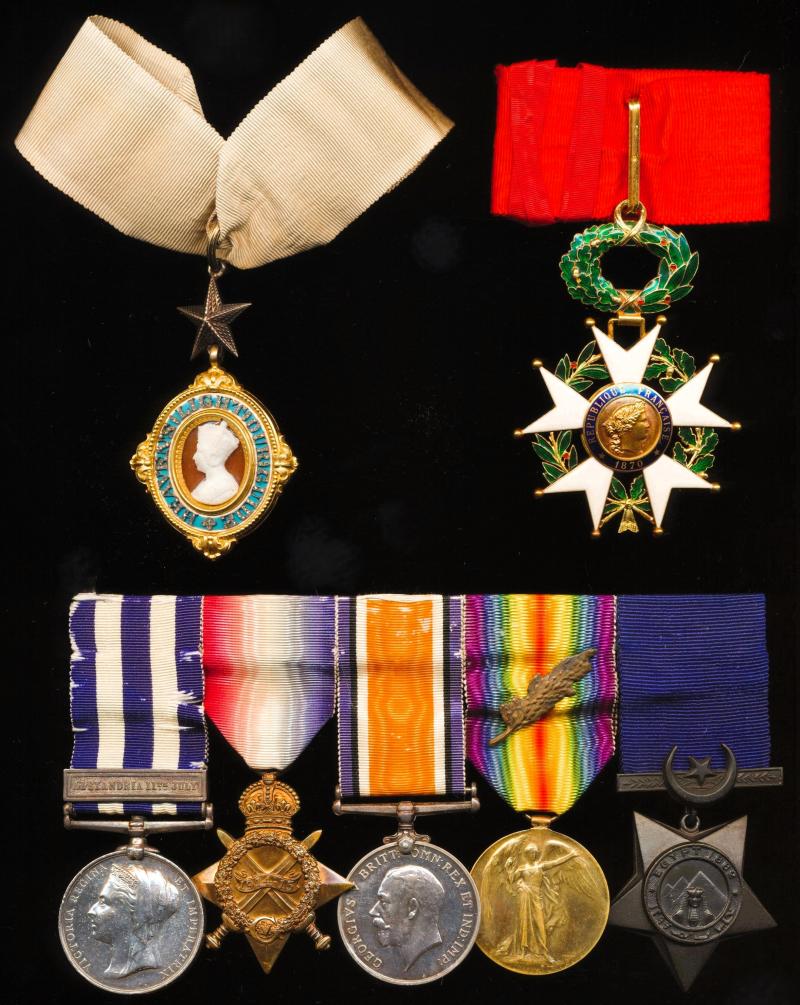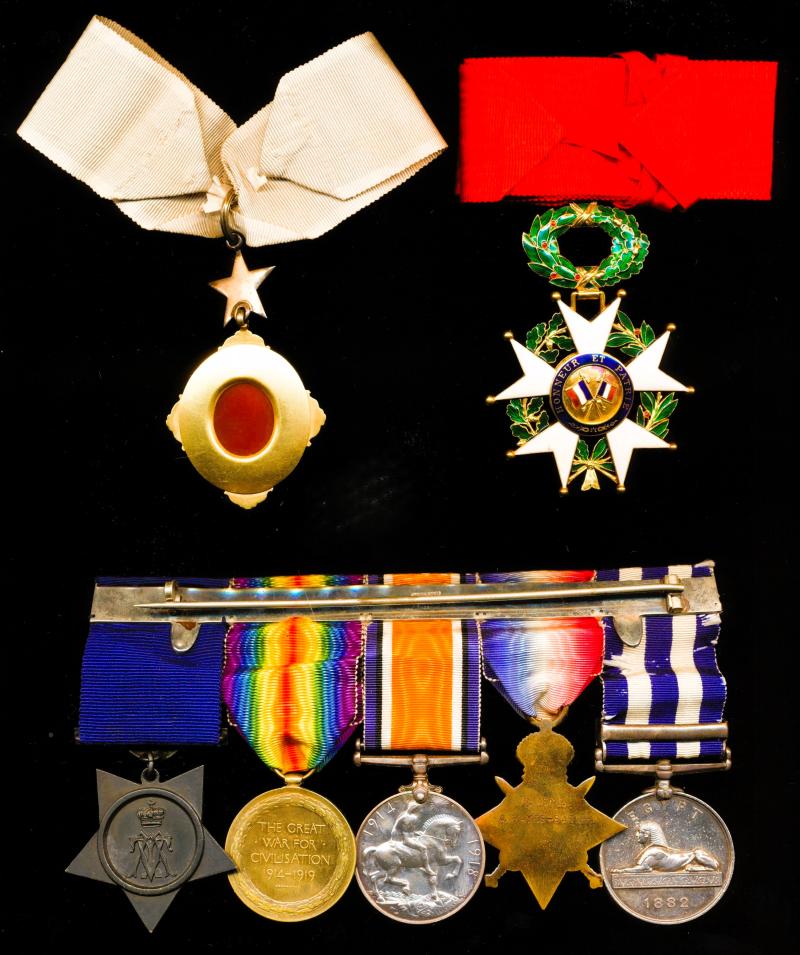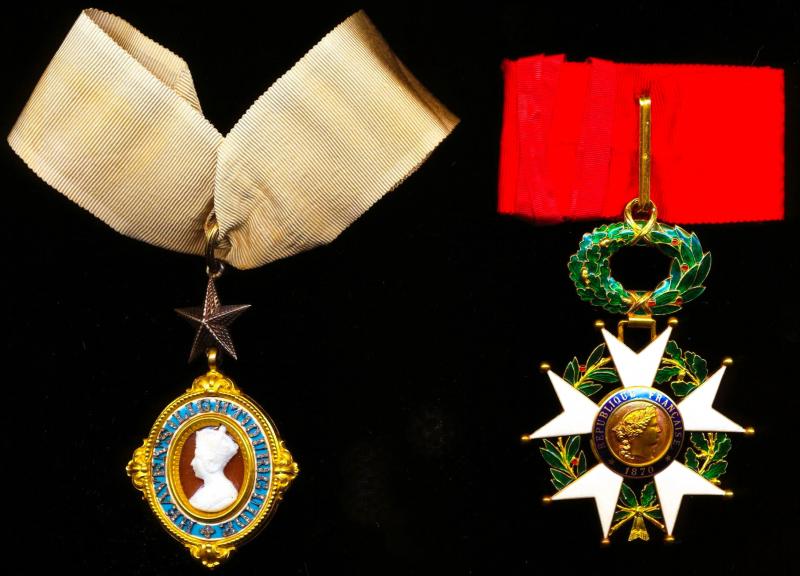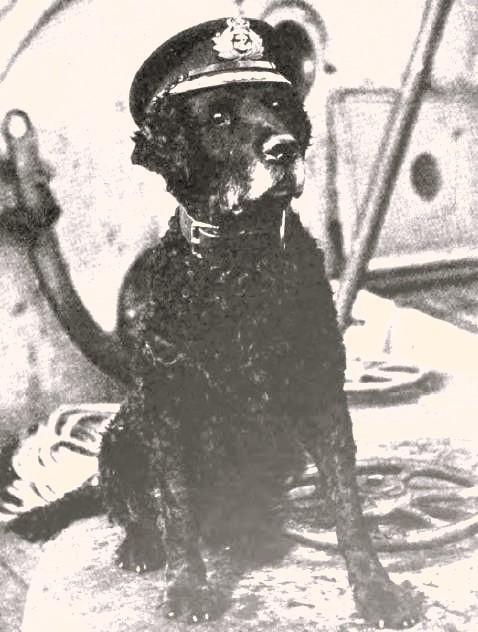The rare group of 7 & 'Archive' of the Naval Officer commanding Persian Gulf Naval Operations 1914-15, later deployed to Dardanelles & was 'Flag Officer' Commanding Aegean Squadron 1918: Rear-Admiral Admiral Arthur Hayes-Sadler, C.S.I., Royal Navy.
- Most Exalted Order of the Star of India. Companion CSI (1916 issue). Gold
- Egypt Medal 82-89. Alexandria 11th July (A. H. Sadler. Midn. R.N. H.M.S. Sultan)
- 1914-15 Star (R. Adml. A. Hayes-Sadler.)
- British War Medal. Silver issue (R. Adml. A. Hayes-Sadler.)
- Interallied Victory Medal. With M.I.D. oak leaves (R. Adml. A. Hayes-Sadler.)
- France: Legion of Honour 'Commander’s neck badge in gold and enamels
- Egypt: Khedives 1882 Star
The Orders, loose and each retaining their original silk 'moire' riband cravats and as -worn. The 5 x campaign medals mounted as-worn in the swing style. The reverse of the mounting bar retaining it's long hinged pin and clasp fittings and as worn by the recipient
Gold Orders: The CSI of 22 Carat gold (unmarked) the insignia (sans riband) being of weight 45g. The French LOH. being of 112mm height (inc suspension) and 58mm width and of the finest craftsmanship in gold (18ct) and enamel, the insignia with French Gold 'Eagle' hallmarks of an 'Eagle's Head' (18ct) on base of tassel on insignia and marked on the gold cravat suspension loop - the weight of the LOH (including riband) is 44g
Sold together with:
- Masonic Knight Templar Jewel: Silver gilt & enamel. Reverse with 'Spencer' makers mark, & English silver hallmark for London 1897. Top bar with & suspension ring both h/m
- Masonic Knight of Malta Jewel: Silver gilt & enamel. Reverse with 'Spencer' makers mark, & English silver hallmark for Birmingham 1906. Top bar & suspension ring both h/m
- Masonic Hall Stone Jewel 1914-18: With makers marks & English Birmingham silver h/m for 1925, named (Bro Rear-Admiral A. Hayes-Sadler No 2612)
All the Masonic awards retaining their original reverse pin fasteners and or, hinged pin mounting brooch
Hayes-Sadler Archive: Also sold together with an extensive - and heavy - archive of original ephemera and manuscript logs as under:
a. Warrant for the C.S.I., dated 4 May 1916, and bearing the signatures of the King and Austen Chamberlain. This was one of only three operational awards of the Star of India given to Naval officers during the entire Great War
b. Original parchment Warrant for the Legion of Honour, dated, Paris, 5 February 1915
c. Two (2 x ) Midshipman’s Logs covering the period 3 February 1879 to 20 June 1883. Both are profusely illustrated with maps, plans of ships, sketches and watercolours. The first volume begins with a superb frontispiece in ink and watercolours, the second volume containing a detailed description of the battle of Alexandria with watercolour illustrations of the forts being bombarded. Both these logs are of considerable importance as a record of Naval operations at the Siege of Alexandria, Occupation of Egypt and Red Sea Naval Operations. Logs are 'heavy' and exteriors with scuffs and chips, spines a/f, with contents clean and bright
d. Two (2) Large 'Lett's' Manuscript Personal diaries kept by Rear Admiral Hayes-Sadler for the years 1917 and 1918. Each with gilt tooled covers and year dates 1917 / 1918. Appertaining to his services in the Mediterranean and Aegean (where in latter he was Flag Officer in Command of the Aegean Station). These diaries contain much detail of historic importance, with much reflection and record of close working with allied forces and diplomats. Including several enclosures of lists of ships and shipping in theatre
Medals & clasp verification: All Orders, medals and clasp confirmed as entitled per the below referenced medal rolls and sources:
- Most Exalted Order of the Star of India. Companion CSI: LG 12 May 1916
- Egypt & Sudan Medal 1882-89. 1882 rev 'Alexandria 11th July': ADM 171/41
- 1914-15 Star: ADM 171/90
- British War Medal. Silver issue ADM 171/90
- Interallied Victory Medal: ADM 171/90
- Mentions-in-Despatches: LG 05/04/16, 12/05/1916 & 05/06/16,
- France: Third Republic Legion of Honour Commander: ADM 171/172 LG 07/04/16
- Egypt: Khedives 1882 Star: ADM 171/41
Arthur Hayes-Sadler was born on 9 October 1865, at Spa, Belgium, son of Sir James Hayes-Sadler, K.C.M.G. He entered the Royal Navy via H.M.S. Britannia on 15 January 1877, and served in various ships until appointed Midshipman on 21 June 1879. In H.M.S. Sultan, he witnessed the bombardment of Alexandria in 1882 and served ashore with the Naval Brigade shortly afterwards. He was thereafter promoted Sub-Lieutenant on 21 June 1883; Lieutenant on 30 June 1886; Commander on 1 January 1890; Captain on 30 June 1904; Rear-Admiral on 19 July 1915; Vice-Admiral on 3 November 1919; and Admiral (Retired) on 1 August 1924.
In October 1914, Hayes-Sadler was ordered to the Persian Gulf in the battleship Ocean to conduct operations against the Turks. The key to the Gulf then, as now, was Basra, the great emporium of Mesopotamian trade, situated 70 miles up the Shatt-al-Arab. On 19 October, Ocean made a rendezvous with Dufferin and elements of the Gulf Expeditionary Force under Brigadier-General W. S. Delamain, and reached Bahrain four days later. On the 31st, the Admiralty sent authority to begin hostilities against Turkey. By 3 November, the convoy was off the outer bar of the Shatt-al-Arab, which Ocean could not cross. Next day, Hayes-Sadler armed various tugs and launches, and prepared to force a passage past the Turkish fort at Fao which guarded the entrance to the river. The following morning he set forth in the sloop Odin with an armed tug, and having silenced Fao’s guns, landed a party of Ocean’s Marines and some 600 troops who threw the enemy’s ordnance into the river. By 10 November, the whole of General Delamain’s force was ashore at Saniyeh awaiting reinforcements under Lieutenant-General A. A. Barrett.
Under German influence, a Jihad had been declared, and therefore prompt action was everything. On the 17th, the land forces advanced, supported by Hayes-Sadler’s sloops, Odin and Espiegle, and two armed launches, providing fire from the river. Having put the enemy to flight, an entrenched camp was established at Sahil, and the wounded evacuated, preparatory to a strike on Basra. It was then learned that the Turks had attempted to block the Shatt-al-Arab with the sunken Hamburg-Amerika liner and two smaller vessels. Accordingly, the next day Hayes-Sadler went upstream to see what could be made of the obstacle. As he approached, he was fired on by a 500-ton gunboat, the Marmariss, by an armed launch and by a battery of 15-pounder Krupp guns. Espiegle replied with such effect that the launch was sunk, the battery silenced and the Marmariss put to flight, without the sloop suffering a single hit. Having ascertained that the obstruction could be cleared to afford a passage, Hayes-Sadler returned to the scene the following day. However, the clearance work had hardly begun when a launch appeared with a deputation from Basra, confirming the rumour that the garrison, evidently in awe of the Espeigle’s performance, had fled and pleading the British to come up and save the city from looting Arabs.
To secure Basra, and capitalise on this success, it was proposed to proceed a further 45 miles to Kurnah on the confluence of the Tigris and Euphrates. During the early days of December, Hayes-Sadler spent much of his time in advance of the main force, conveying troops of the Kurnah detachment, finding suitable landing places, negotiating the uncharted shallows of the river and giving supporting fire. Finally on 8 December, two battalions of the 110th Light Infantry and 104th Rifles, and a Mountain battery, under Colonel Frazer, crossed the Tigris and made a concerted attack on Kurnah. However, it was felt that it was too late in the day to engage in street fighting and the attack was halted. The river flotilla continued firing until sunset and held their positions in readiness for the attack next day. Kurnah, though, had had enough, and early in the middle watch a steamer flying a flag of truce approached. Hayes-Sadler, being unable to communicate with the Generals, then took the surrender of the Turks. Thus, within a matter of weeks from the declaration of war on Turkey, Britain had a firm hold on the water-gate of Mesopotamia. On 13 December he sailed in Ocean for Suez, where he was to become Senior Naval Officer until further orders.
In early 1915, Hayes-Sadler took part in the unsuccessful attempt to neutralise the forts that dominated the straits of the Dardanelles. On 4 March, Ocean was shelling Sedd-el-Bahr in support of survey and beach parties. At noon, Major Palmer, R.M.L.I., responded to a signal from the battleship to report on progress ashore, and communicated that he could not advance without a further 200 men, which Hayes-Sadler at once made ready. However, this request was denied by General Totman viewing operations from Irresistable, with the end result that the troops were forced to retire to the destroyers from which they had started.
On the 18th of the same month, a second attempt was made under a revised plan which gave Hayes-Sadler command of the Second Division, comprising the 3rd, 4th, and 5th sub-Divisions. At 1.45, Admiral de Roebeck ordered the Second Division to relieve the French line which until then had been engaged in hazardous close work. As Hayes-Sadler’s ships took up their positions, the French ship Bouvet was hit with the loss of some 600 men. Closing to a range of 10,600 yards from the shore positions, the ships of the Second Division engaged their respective forts and used their secondary armament against the guns firing on the boats which were rescuing survivors of the Bouvet. By 5.10, the Irresistable was sinking and Hayes-Sadler was standing by to tow her out of action, but the former’s list, combined with the considerable cross-fire made it quite impossible. And so under a heavy fire from Dardanos and Saundere, the Ocean began to withdraw. At about five past six, a sudden heavy explosion announced that she had struck a mine, and almost simultaneously a shell found its mark, causing Ocean to take a list of 15°. Fortunately, Hayes-Sadler was able to signal three passing destroyers, the Colne, Jed and Chelmer, and evacuate the crew, albeit still under fire. However, after dark it was found that four men had accidentally been left aboard and Hayes-Sadler returned in Jed to take them off, leaving the abandoned Ocean to her fate.
From August 1916, Rear-Admiral Hayes-Sadler commanded the British detachment in the Aegean, with his flag in Exmouth and then in Implacable. He went onto the retired list in 1924 and died on 9 February 1952.
Important: Basis the weight of the archive, the postage quoted is for United Kingdom delivery only (and will require 2 x separate packages to be sent). International buyers are, of course welcome, but will have to arrange and pay for their own courier / collection if they wish to retain and keep the very heavy archive
Duke: The old dog wearing the Royal Navy cap shown in the attached 'lot' image is the Admiral's pet dog 'Duke'
A rare and important Naval Flag-Officers medal group and archive
Condition: Orders & masonic jewels EF, the medals mostly GVF. The archive good with bright clean content (a/f)
Code: 24365







